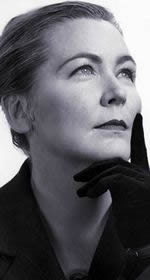Anne
Zielinski-Old literally came to our door one day, curious to see what Fashion Doll Quarterly was up to. Living abroad, but born in New York,
Anne Zielinski-Old was returning to the States with her family, and with her
came an extraordinary portfolio in which the world of fashion and fashion
dolls come together.
In this issue, we are exploring what men want, and what
men are creating and collecting. But it is interesting to note that women
are behind the scenes in the doll world, making beautiful things happen. In
addition to her fascinating career in the world of fashion dolls, Anne was
gracious enough to create a series of 'Pin-Up' illustrations of some of your favorite fashion dolls as a salute to what men
like to see in the pages of a magazine.
©MMIV Reprinted by Kind Permission from Fashion Doll Quarterly

How did you incorporate the world of dolls into your fashion career?
In 1990, while under contract with Fortnum and Mason, London as Creative Consultant, I was called into a meeting with the Managing Director to find Michael Southgate, Creative Director for Adel Rootstein Mannequins waiting to meet me. He had approached Fortnum's with a proposal to incorporate the marketing of their then new 'Frieze' collection of mannequins into a storewide fashion promotion I was working on.
The deal was clinched over lunch at The Ivy and I began my transition from a Fashion Artist, essentially working in two dimensions, to exploring the possibilities of working with the 3-dimensional form. I found myself with new considerations, face paint, wigs, and context and loved every minute of it. Soon after my contract ended with Fortnum & Mason I moved on to a digital research project in the Department of Fashion & Textiles at the Royal College of Art, London. I worked with Patric Old on developing a 3-D digital mannequin for a virtual fashion show called 'Catwalk'. She wore virtual Coco Chanel perfume, breathed and was a living doll! She was stunning...the project was featured in Vogue in 1993. In 1997 I was spotted by Mattel and was recruited as Staff Designer where I developed the dolls and fashions for their Specialty Doll Division.
What type of doll are you most drawn to?
Well, of course, the fashion doll. As a fashion artist, I do see the fashion doll as the 'character merchandising' of the fashion illustration. Having said that, actually, any doll that is exquisitely designed and crafted captures my imagination. Probably the most beautiful dolls I have seen were in the Museum of Costume in Barcelona, a collection of dolls dating back to the 17th century.
Do you have a vision of the perfect fashion doll?
Yes, I do. Naturally, I applied that vision to the new Barbie now used for the Fashion Model Collection. But there were limitations. Time was to be a factor, and cost. Originally, the new doll was planned as the Fortieth Anniversary Barbie. The schedule only enabled the creation of two new arms and two new legs, and I was asked to come up with a new doll as economically as possible.The project was handed to me just two weeks into my tenure at Mattel. In order to fulfill the brief, particularly at such short notice, I drew upon the many years of experience I had. With the emergence of new technologies as a marketing tool, with the Internet on the horizon, the idea behind 'Catwalk' was to put my signature style as a Fashion Artist into cyberspace and create an animated fashion mannequin. I had been working with mannequins from Adel Rootstein as models for my Fashion Art while on contract with Fortnum & Mason. To us, it was logical to team my work with digital technology for use in industry for marketing, and as a design and presentation aid.The digital mannequin is essentially a 3-D animated fashion illustration. The project had been noticed by Maurizio Vechione of Moda CAD, a